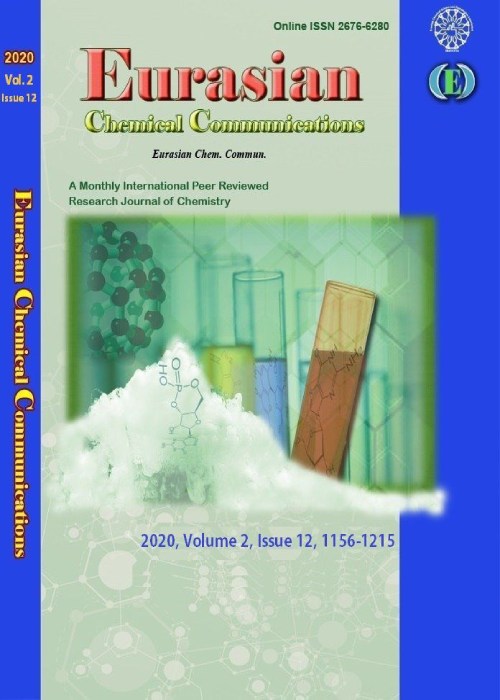فهرست مطالب
Eurasian Chemical Communications
Volume:5 Issue: 3, Mar 2023
- تاریخ انتشار: 1401/12/10
- تعداد عناوین: 7
-
-
Pages 216-2271,2,3,4-Tetrahydro-pyrimidine-5-carbonitrile derivatives were synthesized (compounds 1a-d) by the Biginelli reaction of substituted aromatic aldehydes, cyano-ethyl acetate, and urea/thiourea in absolute ethanol. In the next step, acid compounds (2a-d) were formed via the hydrolysis of nitrile group using sulfuric acid (70%), and condensed with the appropriated amino phenol to give the corresponding N-Aryl-1, 2, 3, 4-tetrahydropyrimidine-5-carboxamide derivatives (3a-d). FTIR, 1H-NMR, and 13C-NMR were used to verify the structures of the discovered compounds. All of these novel compounds yielded spectroscopic evidence consistent with their suggested structures. Compounds having strong anti-fungal action against Candida neoformans (ATCC 208881, H99 Type strain) and Candida albicans (ATCC 90028, CLSI reference) were found by the Communities for Antimicrobial Drug Development in Australia.Keywords: DHPM derivatives, Biginelli reaction, Antimicrobial, Antioxidant, Molecular docking
-
Pages 228-245
γ-Fe2O3@SiO2- Linker-L-Leucine as a new type of recoverable superparamagnetic nanocatalyst was prepared for the first time. The catalyst was identified and its acidity was measured by potentiometric titration through reverse titration method. The catalyst activity was investigated in the three-component one-pot reaction of arylglyoxal monohydrate, cyclic 1, 3-dicarbonyls, and thiobenzamide derivatives in water. The catalyst showed effective catalytic activity for the preparation of a wide range of thiazole derivatives using this green protocol. After the reaction, the catalyst is easily separated by an external magnetic field. The catalyst was used at least five times without losing its high catalytic activity.
Keywords: γ-Fe2O3@SiO2- (L-Leucine), superparamagnetic-recoverable nanocatalyst, thiazoles, Green protocol, arylglyoxal monohydrate, cyclic 1, 3-Dicarbonyls, thiobenzamide -
Pages 246-263Chemical graph theory is a bridge between Chemistry and Graph theory. Graph energies are important tools for QSPR researches. Thus, this study aims to relate several energies with the QSPR analysis of 67 alkanes. We compare these results with the Maximum Degree Energy, Minimum Degree Energy, and Second Zagreb Energy. Our study reveals some interesting results based on the predicting power of these graph energies.AMS 2010 codes: 94C15, 92E10.Keywords: QSPR-analysis, Octane isomers, Maximum Degree Energy, Minimum Degree Energy, Second Zagreb Energy
-
Pages 264-270Carbon nanoflakes were fabricated from domestic waste tea leaves as a bio-alternative source of carbon in one step. The fabricated nanoflakes based-carbon were characterized by field-emission scanning electron microscope, Fourier transform infra-red, energy dispersive X-ray analysis, and Raman spectroscopy. In addition, thermogravimetric analysis was investigated to examine the thermal stability of the products. The morphology of the products showed the observation of carbon-flakes nanomaterials having thin graphitic outer mono shells with a diameter of about 35 nm and different monolith sizes of about 15 to 180 nm. The as-obtained materials demonstrated good thermal stability with a yield of 48% due to the high temperature used in the deposition stage. The fabrication showed that the temperature range of the deposition step in addition to the cooling step plays a major role in the nanoflakes formation.Keywords: bio-alternative, Carbon, Ferrocene, Nanoflakes, Tea Leaves, Wastes
-
Pages 271-281A new series of imidazoles [2,1-b]benzthiazole linked with other heterocyclic scaffolds were synthesized, and a new Mannich base link with a drug (Cefixime) was also synthesized. Oxopyrimidine ring was prepared from reacting Mannich base containing terminal Methyl group condensed with different substituted aromatic aldehydes, producing new chalcones, which undergo ring closer with urea gave new Oxopyrimidine derivatives. All compounds were recognized by Fourier Transform Infrared Spectroscopy, Proton nuclear magnetic resonance and Carbon-13 (C13) nuclear magnetic resonance spectra. Some new compounds were evaluated as anticorrosion agents, and some showed potent inhibition against corrosion.Keywords: curcumin, herbal substances, wound dressing, wound healing, chemical polymer
-
Pages 282-293This work presents syntheses of six new Schiff base compounds from Ampicillin, p-hydroxyl Benzaldehyde reacted with (pentanol, hexanol, and heptanol) to produce (4-pentloxy, 4- hexaloxy, and 4- hepteloxy) Benzaldehyde, and compounds (p-hydroxy, p- chloro, p-nitro) Benzaldehyde used to produce Schiff base compounds. The prepared compounds have been identified using (FT-IR and H1-NMR) techniques. The microscopic phases were determined using a polarized light microscope (POM), and the thermal properties of the transition temperatures for these compounds were measured using a differential scanning calorimeter (DSC). All compounds' melting points, colors, and yields were detected. Then the liquid crystalline behavior was studied, which showed that the compounds gave liquid crystalline properties and determined whether the compounds gave the nematic phase or the smectic phase.Keywords: Schiff base, monomers, liquid Crystal compounds, Ampicillin, Thermal, spectral, physical properties
-
Pages 294-302
Curcumin is among the herbal substances that are of high significance for many researchers as a wound dressing and a wound-healing substance. Curcumin's functioning can be substantially improved by its blending with other natural and industrial components. A systematic review was conducted by searching queries in reliable databases, including Scopus, Web of Sciences, and PubMed. The search results were screened by two researchers employing the Preferred Reporting Items for Systematic Reviews and Meta-Analysis (PRISMA) algorithm. A total of 320 studies were identified, of which 11 were chosen for evidence synthesis. According to the studies, the antimicrobial effect (in 8 studies), mechanical properties (in 7 studies), electrospinning (in 8 studies), and cytotoxicity (in 6 studies) in wound dressings were parameters significantly influenced by blending curcumin with other herbal components and chemical polymers. According to the evidence synthesis results, herbal compounds combined with curcumin improve and strengthen the wound healing property of curcumin.
Keywords: curcumin, herbal substances, wound dressing, wound healing, chemical polymer


